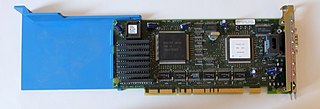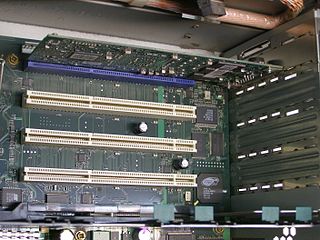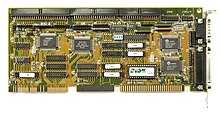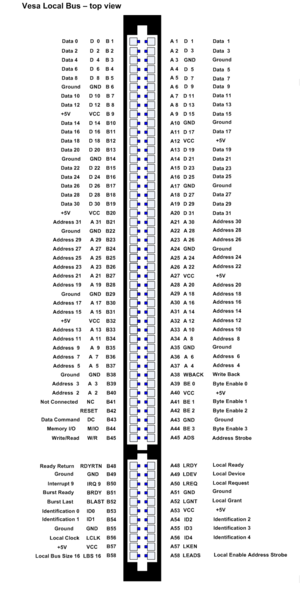
Accelerated Graphics Port (AGP) is a parallel expansion card standard, designed for attaching a video card to a computer system to assist in the acceleration of 3D computer graphics. It was originally designed as a successor to PCI-type connections for video cards. Since 2004, AGP was progressively phased out in favor of PCI Express (PCIe), which is serial, as opposed to parallel; by mid-2008, PCI Express cards dominated the market and only a few AGP models were available, with GPU manufacturers and add-in board partners eventually dropping support for the interface in favor of PCI Express.

The Extended Industry Standard Architecture is a bus standard for IBM PC compatible computers. It was announced in September 1988 by a consortium of PC clone vendors as an alternative to IBM's proprietary Micro Channel architecture (MCA) in its PS/2 series.

Industry Standard Architecture (ISA) is the 16-bit internal bus of IBM PC/AT and similar computers based on the Intel 80286 and its immediate successors during the 1980s. The bus was (largely) backward compatible with the 8-bit bus of the 8088-based IBM PC, including the IBM PC/XT as well as IBM PC compatibles.

The Intel 486, officially named i486 and also known as 80486, is a microprocessor. It is a higher-performance follow-up to the Intel 386. The i486 was introduced in 1989. It represents the fourth generation of binary compatible CPUs following the 8086 of 1978, the Intel 80286 of 1982, and 1985's i386.

A motherboard is the main printed circuit board (PCB) in general-purpose computers and other expandable systems. It holds and allows communication between many of the crucial electronic components of a system, such as the central processing unit (CPU) and memory, and provides connectors for other peripherals. Unlike a backplane, a motherboard usually contains significant sub-systems, such as the central processor, the chipset's input/output and memory controllers, interface connectors, and other components integrated for general use.

Peripheral Component Interconnect (PCI) is a local computer bus for attaching hardware devices in a computer and is part of the PCI Local Bus standard. The PCI bus supports the functions found on a processor bus but in a standardized format that is independent of any given processor's native bus. Devices connected to the PCI bus appear to a bus master to be connected directly to its own bus and are assigned addresses in the processor's address space. It is a parallel bus, synchronous to a single bus clock. Attached devices can take either the form of an integrated circuit fitted onto the motherboard or an expansion card that fits into a slot. The PCI Local Bus was first implemented in IBM PC compatibles, where it displaced the combination of several slow Industry Standard Architecture (ISA) slots and one fast VESA Local Bus (VLB) slot as the bus configuration. It has subsequently been adopted for other computer types. Typical PCI cards used in PCs include: network cards, sound cards, modems, extra ports such as Universal Serial Bus (USB) or serial, TV tuner cards and hard disk drive host adapters. PCI video cards replaced ISA and VLB cards until rising bandwidth needs outgrew the abilities of PCI. The preferred interface for video cards then became Accelerated Graphics Port (AGP), a superset of PCI, before giving way to PCI Express.
Direct memory access (DMA) is a feature of computer systems that allows certain hardware subsystems to access main system memory independently of the central processing unit (CPU).

In computing, an expansion card is a printed circuit board that can be inserted into an electrical connector, or expansion slot on a computer's motherboard to add functionality to a computer system. Sometimes the design of the computer's case and motherboard involves placing most of these slots onto a separate, removable card. Typically such cards are referred to as a riser card in part because they project upward from the board and allow expansion cards to be placed above and parallel to the motherboard.

The Amiga 2000, or A2000, is a personal computer released by Commodore in March 1987. It was introduced as a "big box" expandable variant of the Amiga 1000 but quickly redesigned to share most of its electronic components with the contemporary Amiga 500 for cost reduction. Expansion capabilities include two 3.5" drive bays and one 5.25" bay that could be used by a 5.25" floppy drive, a hard drive, or CD-ROM once they became available.

A graphics card is a computer expansion card that generates a feed of graphics output to a display device such as a monitor. Graphics cards are sometimes called discrete or dedicated graphics cards to emphasize their distinction to integrated graphics processor on the motherboard or the CPU. A graphics processing unit (GPU) that performs the necessary computations is the main component in a graphics card, but the acronym "GPU" is sometimes also used to erroneously refer to the graphics card as a whole.

Micro Channel architecture, or the Micro Channel bus, is a proprietary 16- or 32-bit parallel computer bus introduced by IBM in 1987 which was used on PS/2 and other computers until the mid-1990s. Its name is commonly abbreviated as "MCA", although not by IBM. In IBM products, it superseded the ISA bus and was itself subsequently superseded by the PCI bus architecture.

PCI Express, officially abbreviated as PCIe or PCI-e, is a high-speed serial computer expansion bus standard, designed to replace the older PCI, PCI-X and AGP bus standards. It is the common motherboard interface for personal computers' graphics cards, sound cards, hard disk drive host adapters, SSDs, Wi-Fi and Ethernet hardware connections. PCIe has numerous improvements over the older standards, including higher maximum system bus throughput, lower I/O pin count and smaller physical footprint, better performance scaling for bus devices, a more detailed error detection and reporting mechanism, and native hot-swap functionality. More recent revisions of the PCIe standard provide hardware support for I/O virtualization.

The Personal System/2 or PS/2 is IBM's second generation of personal computers. Released in 1987, it officially replaced the IBM PC, XT, AT, and PC Convertible in IBM's lineup. Many of the PS/2's innovations, such as the 16550 UART, 1440 KB 3.5-inch floppy disk format, 72-pin SIMMs, the PS/2 port, and the VGA video standard, went on to become standards in the broader PC market.

The Amiga 4000, or A4000, from Commodore is the successor of the Amiga 2000 and Amiga 3000 computers. There are two models: the A4000/040 released in October 1992 with a Motorola 68040 CPU, and the A4000/030 released in April 1993 with a Motorola 68EC030.

PCI-X, short for Peripheral Component Interconnect eXtended, is a computer bus and expansion card standard that enhances the 32-bit PCI local bus for higher bandwidth demanded mostly by servers and workstations. It uses a modified protocol to support higher clock speeds, but is otherwise similar in electrical implementation. PCI-X 2.0 added speeds up to 533 MHz, with a reduction in electrical signal levels.

The Tseng Labs ET4000 was a line of SVGA graphics controller chips during the early 1990s, commonly found in many 386/486 and compatible systems, with some models, notably the ET4000/W32 and later chips, offering graphics acceleration. Offering above average host interface throughput coupled with a moderate price, Tseng Labs' ET4000 chipset family were well regarded for their performance, and were integrated into many companies' lineups, notably with Hercules' Dynamite series, the Diamond Stealth 32 and several Speedstar cards, and on many generic boards.

The feature connector was an internal connector found mostly in some older ISA, VESA Local Bus, and PCI graphics cards, but also on some early AGP ones. It was intended for use by devices which needed to exchange large amounts of data with the graphics card without hogging a computer system's CPU or data bus, such as TV tuner cards, video capture cards, MPEG video decoders, and first generation 3D graphic accelerator cards. Early examples include the IBM EGA video adapter.
GIO is a computer bus standard developed by SGI and used in a variety of their products in the 1990s as their primary expansion system. GIO was similar in concept to competing standards such as NuBus or (later) PCI, but saw little use outside SGI and severely limited the devices available on their platform as a result. Most devices using GIO were SGI's own graphics cards, although a number of cards supporting high-speed data access such as Fibre Channel and FDDI were available from third parties. Later SGI machines use the XIO bus, which is laid out as a computer network as opposed to a bus.
The ATI Mach line was a series of 2D graphics accelerators for personal computers developed by ATI Technologies. It became an extension to the ATI Wonder series of cards. The first chip in the series was the ATI Mach8. It was essentially a clone of the IBM 8514/A with a few notable extensions such as Crystal fonts. Being one of the first graphics accelerator chips on the market, the Mach8 did not have an integrated VGA core. In order to use the first Mach8 coprocessor cards, a separate VGA card was required. This increased the cost of ownership as one had to purchase two rather than one expansion card for graphics. A temporary solution was presented with the ATI Graphics Ultra/Vantage cards, which combined an ATI 8514 Ultra and VGA Wonder+ into a single card. The Mach32 chip was the follow-up to the Mach8, which finally featured an integrated VGA core, true colour support and a 64-bit datapath to internal memory.

The Personal Computer Series, or PC Series, was IBM's follow-up to the Personal System/2 and PS/ValuePoint. Announced in October 1994 and withdrawn in October 2000, it was replaced by the IBM NetVista, apart from the Pentium Pro-based PC360 and PC365, which were replaced by the IBM IntelliStation.





















